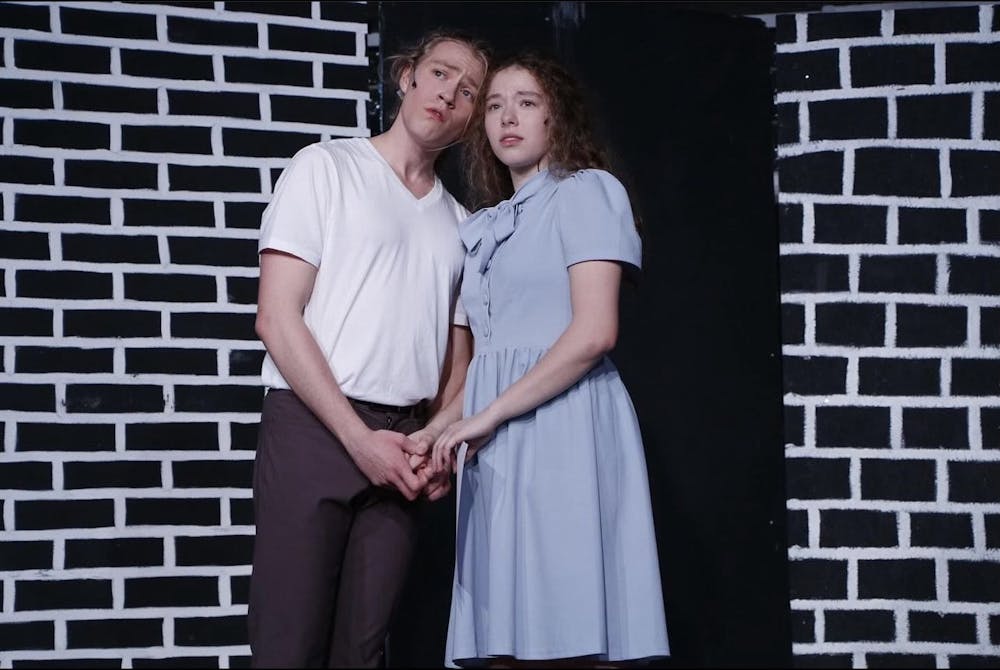Spectrum Theatre, one of the University’s student-run theater organizations, launched their spring 2024 production of Steven Sater and Jessie Nelson’s musical, “Alice by Heart” in the Student Activities Building Thursday. Xander Tilock, the show’s director and second-year College student, introduced the show by characterizing it as “a question not an answer.” An exploration of grief and trauma, the production perfectly embodies Spectrum's mission to “challenge and engage audiences” by representing the blurry boundaries between reality and illusion.
“Alice by Heart'' twists the narrative of Lewis Carroll’s novel, “Alice in Wonderland'' by combining its fantasy elements with a historical narrative. Katie Haines, the show’s dramaturg and third-year College student, describes the show as a Bildungsroman — or coming of age story — which is evident through its thematic elements of innocence, growing up and profound emotions.
The show unfolds during the London Blitz, a year-long period of destructive bombing attacks carried out by Germany against the United Kingdom during the 1940s. When teenager Alice Spencer’s copy of “Alice in Wonderland” is ripped apart by her nurse as punishment for visiting her quarantined friend Alfred Hallam, she resorts to reciting the tale by heart. The production shifts between the mythical Wonderland and the horror-stricken reality of the bombings in London with characters morphing between roles in an instant.
Alice Spencer, played by first-year College student Laila Bolté, takes the audience with her as she traverses between the two worlds. This journey results in a convoluted psychological undertone which underscores the show's theme of escapism versus acceptance.
Bolté’s portrayal of Alice Spencer is one to be commended. Her depiction of the character's unwavering optimism resonates through the hopeful intonations in her singing, complemented by expressions that evoke sympathy from the viewers.
This sense of optimism is often met with an opposite attitude from supporting characters who antagonize Spencer — like Hallam, the White Rabbit and March Hare. First-year Engineering student Soren Corbett brings these three characters to life, embodying a sense of urgency in each scene. Corbett's hurried delivery of his dialogue, in tandem with his character's continual quivers and nervous tics, heightens an aura of desperation that defines all three of the characters.
Skillful acting by the performers was complemented by dazzling technical elements. Despite the spatial constraints of the stage in the SAB, Spectrum’s artistic vision for the play immersed the audiences through its dramatic usage of light and sound. Contrasting lights mirrored the opposite realms depicted in the scenes, as a fiery orange haze fermented audiences in a catastrophic reality and an iridescent blue delineated the dream-like states of Wonderland.
In addition to the masterful use of colored lights, sequences of hypnotic visuals and spotlights drew attention to the characters’ frames of mind. The song, “Afternoon,” a tune about longing and nostalgia, features a haunting unity between Alice and Alfred as the spotlights wander between the two characters. Even as the light primarily focuses on Alice as Alfred moves past her, Alice's unwavering fixation on their connection becomes the focus as the lights eventually converge on both characters.
To balance out the pronounced visual elements of the show, the technical team masterfully used sound to evoke the script’s eerie undertones. An impressive intersection between the show’s musical elements and the actor’s strengths was the musical number, “Brillig Braelig.” Actors worked in cohesion to reverberate the echo of their stomping feet alongside their bolstering voices. Third-year College student Benjamin Barnes, who plays the lead in this song as the Jabberwock, captivated the crowd through his deepened depiction of the character's demeanor and intimidation. A chilling sequence, this scene was distinguished by the actors’ erratic motions and the roaring harmony of their voices, creating a captivating moment for the audience.
With its dazzling costumes, hypnotic atmosphere and morally complex characters, Spectrum’s production of “Alice by Heart” struck a chord with audiences through both emotional depth and fantastical execution. Despite the complicated background filled with mythical creatures and historical plotlines, viewers can relate to the play in its simplest form — a story of wanting to hold on to nostalgic escapism in light of harsher realities.
CORRECTION: A previous version of this article incorrectly stated that the song “Afternoon” was sung between the characters Alice and Albert. Instead, the song was sung between Alice and Alfred. The article has since been updated to reflect this change.







